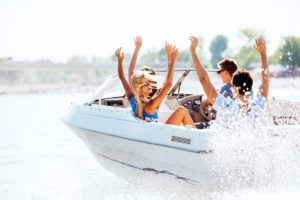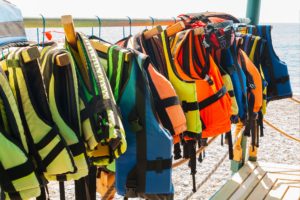Before you step foot on the boat or secure your feet into your wakeboard bindings, you want to be sure that you stay safe by wearing a proper-fitting life jacket. Maybe you’re new to water sports and are looking for your first one. Or maybe it’s time to replace that 20-year-old life vest you’ve been keeping stored in your shed. Whatever the reason, it’s important to know how to choose the best one for you as you’re browsing options.
What life jacket options are available?
You may be surprised to learn that when it comes to personal flotation devices, or PFDs, there’s quite a variety to choose from! Some are Coast Guard Approved (CGA) while others are not, which we’ll get into later in this post. Some are designed specifically for sports such as wakeboarding while others work for a wider variety of water activities.
One thing you’ll want to decide is whether you want a standard life jacket or one that’s inflatable. Standard life jacket options are filled with foam and other materials that keep them afloat. These are what most people wear while out on the water. The one downside to them, however, is that they can take up a lot of space, especially if you’re trying to store an option for you and each member of your family.
Many inflatable PFDs work by pulling a tab when you wish for the vest or belt to inflate, which allows a CO2 cartridge to activate and inflate your device. This takes more thought and is only recommended for water activities such as paddleboarding or kayaking. Inflatable PFD belts are a great choice for these sports since you stay cooler with less layers and have more freedom to move. However, keep in mind that they aren’t suitable for children and are recommended for those who can swim well and feel confident on and in the water.
Life Jacket Sizing
If you’re not able to go to a store to try on a new life jacket, you may be a bit stumped when trying to select the right size. First of all, it’s important to know that for adults, finding the right flotation is determined by your size and not your weight, whereas for children, weight is the deciding factor. To find your size, measure the circumference of the widest part of your chest. Then look at the sizing chart provided by the brand of life vest you are looking to buy. Different brands may vary slightly in their sizes, so it’s important to check this before purchasing.
What does Coast Guard Approved (CGA) mean?
You’ve maybe noticed some flotation options say “U.S. Coast Guard Approved” listed in their features. You might be wondering, what does this mean and is it important information when helping you choose what to buy?
It sure is! In short, a Coast Guard Approved life vest provides adequate flotation in case of emergency by allowing your head to stay above water while you’re wearing it. According to the law, a water vessel must have a CGA flotation for each individual on board. This means that even if you and a few friends are going out for a short pontoon ride, you must have a CGA life jacket for each member of your group. A Non-CGA life jacket will still provide flotation, but it is not recommended for use during an emergency.
There are also different numbers associated with types of life jackets, which you may have also noticed if you’ve been looking at their key features. These and their definitions are listed below:
Type I
These are the bulkiest type of life jacket but also offer the most protection. They are best used when out on rough waters, in the ocean, somewhere where rescue might not be readily available, or for those who don’t know how to swim or aren’t comfortable swimming. They are designed to keep a person’s face above the water, even if they are unconscious. You will likely find these on commercial vessels such as ships, ferries, etc.
Type II
These are similar to type I flotations, only they’re a little less bulky. They are also designed to keep an unconscious person’s face out of the water. They are better suited for calmer waters or places where rescue might be quicker.
Type III
This type of life jacket is best used for water activities such as tubing behind a boat, canoeing, kayaking, etc. They are not designed to keep you face up, but they still provide adequate flotation for being out in calm waters.
Type IV
This is actually not a life jacket, but rather, a device that is thrown into the water for a person to grab onto until they are rescued.
Type V
These flotations are for specific activities such as whitewater rafting, kayaking, waterskiing, and more. They are not recommended for wearing during emergencies if you have a better option on hand.
Wakeboard Vests
While looking at life jacket options, you’ve likely noticed that many are labeled specifically as wakeboard vests. Wakeboarding vests are lightweight and offer more freedom of movement than traditional life jackets. They also can help protect against injuries caused by wiping out. However, most wakeboard vests are not CGA. Many of them don’t offer nearly as much flotation as a standard life vest does, so therefore, they are not recommended for children, beginners, or those who are not strong swimmers.
Those of you who prefer wakesurf boards may consider these types of vests as well.
Other Life Jacket Features
Are there any specific features you’re looking for when selecting a life jacket? Keep some of them in mind as you’re searching! Pockets can be nice for storing small items. Color can be an important decision maker, whether you want something to match your style or you want something to help you be easily spotted. Some life jackets also have reflective tape which can help you be seen at night. Also, adjustable features, such as buckles and straps versus zippers, if you’re not sure on sizing, having just the right amount of give can make the life jacket more versatile.
Keeping all of this information in mind, we hope that now you feel a little more prepared when picking out the perfect life jacket option for you and the entire family! Be sure to check out our entire watersports shop so that you can stock up on all the gear you need to make your summer a great one!








